Tatsǫ́ Nǫgére Gǫ́né Naarı́chú
This is a unilingual story with hand-drawn illustrations and Dene text. It involves Fox, Raven, and Bear, and has a questionnaire for students in Dene at the end of the story. It begins a long time ago:
Yahnı̨́ı̨ ts’ę́ Sah ɂı̨́hts’ę ts’ę nǫgére gǫ́né dene ghá nerıchú. Eyıı t’á nǫgére eyáı̨lı̨ zǫ t’á wetı̨ zǫ redı.
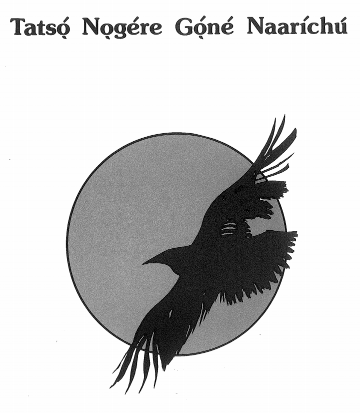
Access this Resource:
Available from the Ɂehdzo Got’ı̨nę Gots’ę́ Nákedı archives. Contact This email address is being protected from spambots. You need JavaScript enabled to view it. for access and see the Release and User Agreement form on the database home page.
Taneton, Louie, Shelia Hodgkinson [Illustrations], Fibbie Tatti and Jane Modeste [eds.] Tatsǫ́ Nǫgére Gǫ́né Naarı́chú. Copyright Fort Franklin Band Council. Programs and Evaluatıon Branch, Department of Education, Northwest Territories, 1983.
Tatsǫ́ Dek’árı́hkwelé Yáı̨́hts’é
This is a unilingual story with hand-drawn illustrations and Dene Kedǝ text. At the beginning, it contains a vocabulary page with images and Dene Kedǝ terminology. The story begins a long time ago:
Yahnı̨́ı̨ ts’ę́ Tatsǫ́ ɂı̨hbé náts’edé ta nágwe redı. Dene łée sı̨́ı̨ betúé bédaarat’ı̨ dúwé t’á ɂehke ke yegereké dúwé redı.
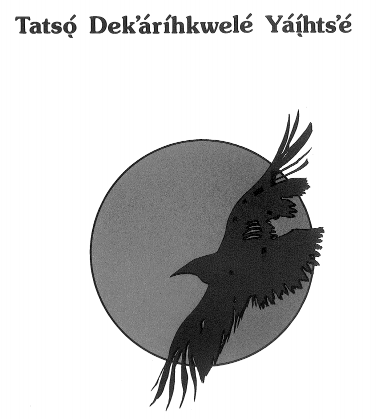
Access this Resource:
Available from the Ɂehdzo Got’ı̨nę Gots’ę́ Nákedı archives. Contact This email address is being protected from spambots. You need JavaScript enabled to view it. for access and see the Release and User Agreement form on the database home page.
Taneton, Louie, Jane Modeste, Fibbie Tatti, Sheila Hodgkinson [Illustrations]. Tatsǫ́ Dek’árı́hkwelé Yáı̨́hts’é. Yellowknife, Programs and Evaluation Branch, Department of Education, Government of the Northwest Territories, 1983.
Neshíkwı́h
This is a unilingual story with hand-drawn illustrations and Dene text about a giant lake creature, and a time where Dene could change from dene to animal and back. The story begins a long time ago:
Yahnı̨́ı̨ ts’ę́, too yatı̨ ekúhye ejo, Delıne dene Neshıkwıh héradı sı̨́ı̨ be hé tę́ neréhwé redı. Suré dnee edárıyeh ǫ́t’e. Jú ts’ę́ réya ekǫ́ be hé tę́ nı̨hkw’e.

Access this Resource:
Available from the Ɂehdzo Got’ı̨nę Gots’ę́ Nákedı archives. Contact This email address is being protected from spambots. You need JavaScript enabled to view it. for access and see the Release and User Agreement form on the database home page.
Taneton, Louie, Jane Modeste, Fibbie Tatti, Sheila Hodgkinson [Illustrations]. Neshíkwı́h. Northwest Territories Department of Education, Programs and Evaluation Branch and Fort Franklin Band Council, 1983.
Kwı́gah
This is a unilingual story with hand-drawn illustrations and Dene text. A Dene man goes hunting and shoots bear cubs. The bear’s mother sees this and is very angry. She comes after the man, but he puts a stick in her mouth so she cannot close her jaw. She was stuck, and he got away safely. There is a quiz in Dene for students to complete once they have read the story. The narrative begins:
Yahnı̨́ı̨ ts’ę́ sah gode góı̨lé redı, Saoyu k’e, beyaa nákee yé hé k’énaɂá, jı́ı yágıdé.
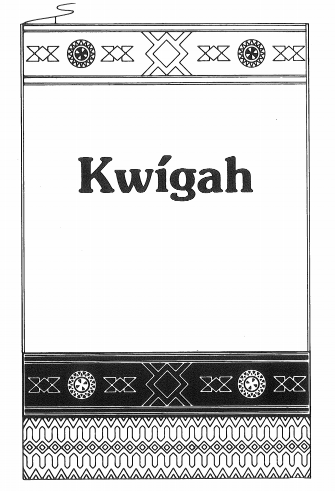
Access this Resource:
Available from the Ɂehdzo Got’ı̨nę Gots’ę́ Nákedı archives. Contact This email address is being protected from spambots. You need JavaScript enabled to view it. for access and see the Release and User Agreement form on the database home page.
Taneton, Louie, Jane Modeste, Fibbie Tatti, Sheila Hodgkinson [Illustrations]. Kwı́gah. Northwest Territories Department of Education Programs and Evaluation Branch and Fort Franklin Band Council, 1983.
Learning: Tradition & Change in the Northwest Territories
From Abstract:
"In 1981-82 the Legislative Assembly's Special Committee on Education held 43 public hearings throughout the Northwest Territories to gather information on all aspects of public concern about education. Written in English and Inupiaq, this document outlines problems related to: (1) preparation for a traditional Native life versus preparation for the wage economy; (2) choosing among bilingual, Native language, and English-as-a-Second-Language programs; (3) the need for culturally appropriate curriculum and instructional materials; (4) poor attendance and high dropout rates; (5) discipline problems; (6) lack of Native teachers; (7) inadequacy of preservice and inservice teacher education in preparing southern teachers for northern schools; (8) the need for parent education and parent-school liaisons; (9) the need for adult and continuing education; (10) limited funding; and (11) large differences between educational policies and classroom practices. The Special Committee made several major restructuring recommendations, including the creation of: 10 divisional boards of education to govern schools with the advice of local educational authorities; a Secretariat of Learning to respond to demands for learning from the private and public sectors; two centers responsible for curriculum development and teacher education; and an Arctic College. In addition, 49 specific recommendations address issues of administrative structure, school programs and curriculum, language of instruction, teacher education and recruitment, special education, adult education, and policy implementation. This document contains a bibliography of approximately 270 items.”
Access this Resource:
Northwest Territories Legislative Assembly: Special Committee on Education. Learning: Tradition & Change in the Northwest Territories. Yellowknife, 1982.
Túrı Ɂerı̨ı̨htłé Dı̨ı̨
This is a unilingual story with hand-drawn illustrations and North Slavey text. From the illustrations, it appears to be about the different ways to hunt and eat ducks.
Túrı wegéhkw’ę. Túrı denadé wegéhkw’ę. Túrı denadé ghágeda.
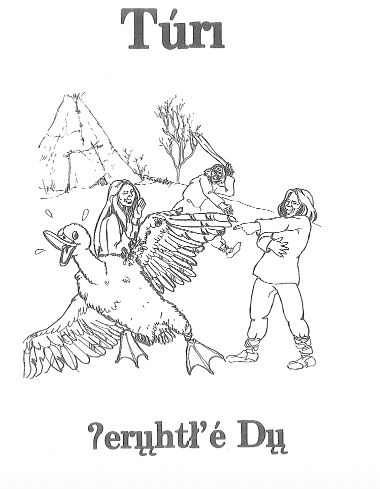
Access this Resource:
Available from the Ɂehdzo Got’ı̨nę Gots’ę́ Nákedı archives. Contact This email address is being protected from spambots. You need JavaScript enabled to view it. for access and see the Release and User Agreement form on the database home page.
Modeste, Jane, Cynthia Chambers hé Gloria Lafferty. Túrı Ɂerı̨ı̨htłé Dı̨ı̨. Northwest Territories Department of Education. Programs and Evaluation Branch, 1982.
Making Literacy in the Northern Dene Languages Functional
Chambers’ presentation provides valuable context for the work in curriculum development and written language documentation occurring in the early 1980s.
From the Introduction:
“Hello. My name is Cynthia Chambers. For the past two years I have been working with the Department of Education in Yellowknife, Northwest Territories in Canada, as a curriculum developer. The curriculum I have been developing has been in the northern Dene languages for use in the Territorial schools. A majority of my time has been spent in the preparation of materials for the Chief Jimmy Soldat School in Fort Franklin, N.W.T., which has been a pilot project for the use of a Dene Language as the language of instruction from kindergarten to grade two, since 1979. In conjunction with this work, I have been involved in numerous inservice training workshops with Dene classroom assistants (teacher aides) and teachers. These workshops have covered a number of topics including literacy training and methodology but most importantly what might be aptly coined as sociology of Dene bilingualism.
The various aspects of my work have, over the last two years, forced me to examine some of the issues in curriculum development in northern Dene languages. It is really a brief synopsis of my examination of these issues that I would like to share with you now.
Many of these issues have involved the disciplines of psychology and linguistics. The lack of hard core linguistic research data on early and middle year Dene language acquisition; as well as psychological research on the cognitive development, cognitive categories and strategies of Dene children have severely hampered our ability to develop program materials based on research evidence. Without such research we have no basis from which to develop an evaluation mechanism for either our first or second language programs. We have no evidence to indicate how effective our present programming has been and what areas require improvements or change. The dearth of research has meant that we have not even tried to develop a mechanism for testing children’s oral proficiency in the Dene languages; a tool we sorely need in so many of our schools where the school population has mixed proficiency in the Dene languages. We must know how well the children understand and speak the language before a program can be developed and they can be grouped for introduction. The general lack of scientific and applied research in all of these areas has hampered the development of effective Dene language programs. Because to date most of the curriculum development has been in the language arts area for a Dene as the Language of instruction [xxx], we have tried to apply modern reading theory to the development of a tertiary level literacy program."
Access this Resource:
This conference paper is held in the NWT Archives: accession no. 2007-14 (Cynthia Chambers Collection).
Chambers, Cynthia. “Making Literacy in the Northern Dene Languages Functional.” Arcata: Second Annual Athapaskan Linguistics Conference, 1981.
Sahtú Got’ine Gokedeé: A Slavey Language Pre-Primer in the Speech of Fort Franklin
This document consists of 45 charts; each one contains a picture, a word, and a sound within that word. For example, a picture of a frog, “ts’aleh,” then “ts’”.
Foreword: This is one of a series of experimental texts and learning units prepared for use in the Chief Jimm Soldat School in Fort Franklin. If this material works well there, we hope it can serve as a model for other teachers of Athapaskan languages elsewhere. We would be delighted to hear of it being used, adapted or even copied by other Athapaskan teachers. (S.T. Mallon, Linguistic Programmes Division, Department of Education, Northwest Territories).
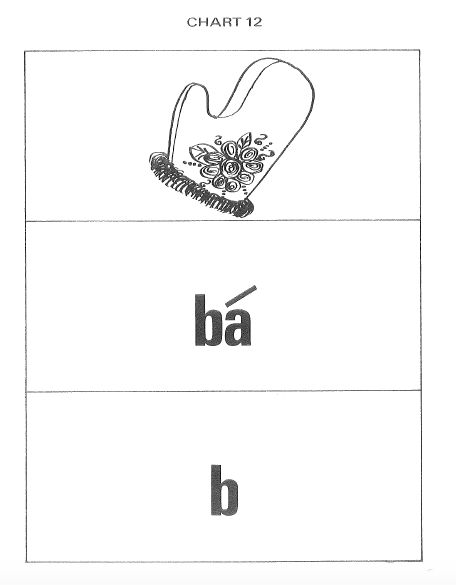
Access this Resource:
Tatti, Fibbie, and Philip Howard. Sahtú Got’ine Gokedeé: A Slavey Language Pre-Primer in the Speech of Fort Franklin. Yellowknife: Northwest Territories Department of Education. Linguistic Programs Division, 1978.
Technical Reports: Education in the Canadian North
This paper contains three short reports. The first deals with applying the concept of community-guided education, and the second discusses northern teacher training. Both are based on applied research. The third report covers the preparation that southern teacher candidates undergo before heading north.
The aforementioned research projects stem from a 1970 conference in Inuvik, “The Man in the North Inuvik Conference,” which discussed important issues in northern community development, and highlighted a lack of community involvement in formal education. Conference participants called for involvement of elders and native teachers, particularly in lower grades, to help guarantee cultural continuity and allow students to ease into the school environment, feeling understood culturally and linguistically. Task forces were assigned to research these proposals at various sites, and Site III was Great Bear Lake (boundaries not clearly defined).
Abstract:
The 3 research topics examined in this report are identified as crucially important by the 1970 Man in the North Inuvik Conference. Eskimo, Indian, and Metis residents of the North comprise 2/3 of the conference participants. The first 2 reports are on applied research projects, the first dealing withsome practical ways to apply the concept of community-guided education, the second with training northern native teachers. The third report is a study of southern teacher preparation for professional teaching in the North. Three conclusions appear most significant for the present stage of northern education: (1) while official directives concerning northern education seem to be promising, very often they lack comprehension from the administrators, the teaching staffs, and concerned populations; (2) local committees must have well-defined responsibilities in the selection, hiring, transfer,and dismissal of teachers; and (3) efforts to post native teachers to the elementary grades should not exclude new and imaginative formulas that depart from the sempiternal tendency to accommodate northern elementary teacher training to the already existing standards and procedures of the South. (HEC)
Access this Resource:
See WorldCat for a list of libraries that hold this resource.
Brown, Doug, H.T. Murphy, Rosalee Tizya, Eric Gourdeau, and Ghislain Girard. Technical Reports: Education in the Canadian North. Montreal: Arctic Institute of North America, March 1973.


 Phone: 867-374-4040
Phone: 867-374-4040 Email:
Email: